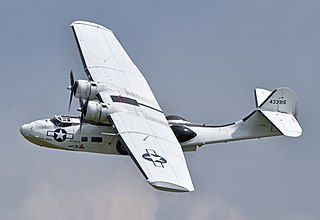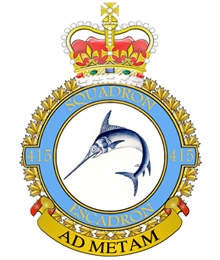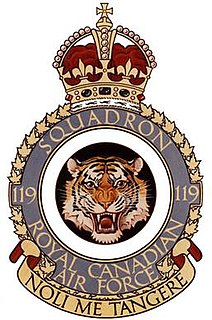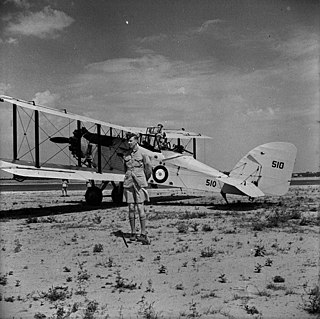
The Consolidated PBY Catalina is a flying boat and amphibious aircraft that was produced in the 1930s and 1940s. In Canadian service it was known as the Canso. It was one of the most widely used seaplanes of World War II. Catalinas served with every branch of the United States Armed Forces and in the air forces and navies of many other nations. The last military PBYs served until the 1980s. As of 2021, 86 years after its first flight, the aircraft continues to fly as a waterbomber in aerial firefighting operations in some parts of the world. None remain in military service.

The Supermarine Stranraer was a flying boat designed and built by the British Supermarine Aviation Works company at Woolston, Southampton. It was developed during the 1930s on behalf of its principal operator, the Royal Air Force (RAF).

No. 428 Squadron RCAF, also known as 428 Bomber Squadron, and 428 Ghost Squadron, was first a night bomber squadron of the Royal Canadian Air Force engaged in strategic bombing during World War II, based in Yorkshire. At the end of the war the squadron moved to Nova Scotia before being disbanded in September 1945. In 1954 the squadron was reformed as 428 All-Weather (Fighter) Squadron, before being again disbanded in 1961.

424 Transport and Rescue Squadron, nicknamed "Tiger Squadron", is a Royal Canadian Air Force strategic transport and search and rescue unit based at Canadian Forces Base (CFB) Trenton in the Canadian province of Ontario. The squadron is the primary provider of search and rescue response for the Trenton Search and Rescue Region, which extends from Quebec City to the Rocky Mountains, and from the Canada–United States border to the North Pole, covering an area of over ten million square kilometres in Central, Western, and Northern Canada.

415 Long Range Patrol Force Development Squadron is an air squadron of the Royal Canadian Air Force that first saw service during the Second World War.

No. 162 Squadron RCAF was a unit of Royal Canadian Air Force Eastern Air Command. Formed as a bomber reconnaissance squadron at RCAF Station Yarmouth, Nova Scotia, Canada on 19 May 1942 with Canso A aircraft, the squadron spent an uneventful eighteen months on east coast anti-submarine duty. In January 1944, it was seconded to RAF Coastal Command and moved to RAF Reykjavik, Iceland to cover the mid-ocean portion of the North Atlantic shipping route. On April 17, Flying Officer T. C. Cooke and his crew attacked and sank U-342 while on a meteorological flight west of Iceland.

No. 8 Squadron RCAF was a unit of the Royal Canadian Air Force (RCAF) that was in operation from 1936 to 1945.

No. 119 Squadron was an RCAF Canadian Home War Establishment (HWE) Squadron. Created 15 May 1935 in Hamilton, Ontario, it came to be tasked with coastal patrol and anti-submarine duty over the Gulf of St. Lawrence and the Atlantic Ocean around Nova Scotia. It was disbanded 15 March 1944 in Sydney, Nova Scotia.

439 Combat Support Squadron is a squadron of the Royal Canadian Air Force, based in Bagotville, Quebec.

No. 4 Squadron was a Royal Canadian Air Force squadron that was active before and during the Second World War. It was formed on 17 January 1933 at RCAF Station Jericho Beach and flew civil operations until 1939, conducting forestry, customs and fishing patrols as well as aerial photography. On 1 January 1938, it was redesignated a General Reconnaissance squadron but continued with the same aircraft, but began training for war operations.
No. 7 Squadron was a Royal Canadian Air Force squadron that was active during the Second World War.
No. 9 Squadron RCAF was a Royal Canadian Air Force squadron active during the Second World War, primarily in an anti-submarine role with Western Air Command and was based at Bella Bella, British Columbia. The squadron flew the Supermarine Stranraer, Consolidated Canso and Consolidated Catalina before disbanding on 1 September 1944.
No. 5 Squadron RCAF was a Royal Canadian Air Force squadron that was active during the Second World War. It was primarily used in an anti-submarine role with Eastern Air Command and was based at Dartmouth, Nova Scotia, Gander, Newfoundland, Torbay, Newfoundland, Yarmouth, Nova Scotia and Sydney, Nova Scotia. The squadron flew the Supermarine Stranraer, Consolidated Canso and Consolidated Catalina before disbanding on 15 July 1945.
Western Air Command was the part of the Royal Canadian Air Force's Home War Establishment responsible for air operations on the Pacific coast of Canada during the Second World War.
No. 116 Squadron was a Royal Canadian Air Force squadron that was active during the Second World War. It was originally formed as a Coast Artillery Co-operation squadron and then a fighter squadron before being disbanded in 1939, and then reformed in 1941. It was primarily used in an anti-submarine role and was based at Dartmouth and Sydney, Nova Scotia and Gander, Newfoundland. The squadron flew the Catalina and Canso before disbanding on 20 June 1945.
No. 13 Service Flying Training School RCAF was a RAF flight training unit flying Avro Ansons from RCAF Station St Hubert, Quebec and later from RCAF Station North Battleford, Saskatchewan. It was part of No. 3 Training Command RCAF carrying out British Commonwealth Air Training Plan ("BCATP") operations.
No. 2 Squadron was a Royal Canadian Air Force (RCAF) squadron active during the late 1930s. The squadron operated army cooperation aircraft from 1935, and upon the outbreak of World War II was selected for overseas duty. However, a shortage of aircraft forced its disbandment in late 1939 to reinforce two other squadrons.
No. 3 Training Command RCAF was a training command of the Royal Canadian Air Force during World War II established to administer the schools of the British Commonwealth Air Training Plan.

No. 3 (Bomber) Squadron was a Royal Canadian Air Force (RCAF) squadron active during the late 1930s.











